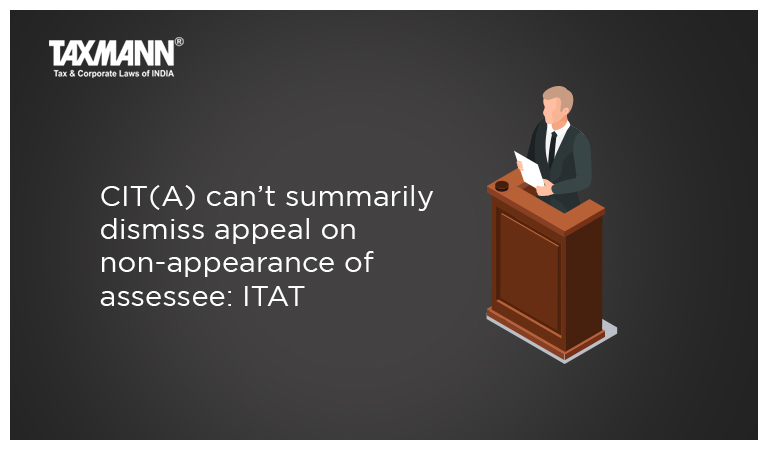CIT(A) can’t summarily dismiss appeal on non-appearance of assessee: ITAT
- Blog|News|Income Tax|
- 2 Min Read
- By Taxmann
- |
- Last Updated on 22 July, 2022

Case Details: Marvel Industries Ltd. v. DCIT - [2022] 140 taxmann.com 430 (Mumbai-Trib.)
Judiciary and Counsel Details
-
- Pramod Kumar, Vice-president & Pavan Kumar Gadale, Judicial Member
- Shailja Rai for the Respondent.
Facts of the Case
The instant appeal was filed by the assessee against ex parte order passed by the CIT(A). The assessee contended that CIT(A) simply dismissed the appeal summarily without even referring to the elaborate statement of facts and specific issues raised in the grounds of appeal.
ITAT Held
The Mumbai Tribunal held that the scheme of section 250 does not visualize any situation in which an appeal can be summarily dismissed disregarding the material on record. Section 250(6) lays down that the CIT(A)’s order
“disposing of the appeal shall be in writing and shall state the points for determination, the decision thereon and the reason for the decision”.
As for the points of determination, it cannot be open to the CIT(A) to disregard what the assessee has placed before him by way of a statement of facts and the grounds of appeal.
An assessee has “the right to be heard at the hearing of the appeal” and such a right cannot be put against the assessee. Before an appeal can be disposed of, a fair and reasonable opportunity of hearing is to be essentially extended to the assessee. The non-exercise of this right by the assessee cannot be a reason enough for the CIT(A)’s not dealing with the points so raised before him on merits.
The exercise of the “right to be heard at the hearing of the appeal” by “the appellant, either in person or by an authorized representative condition”, under section 250(2)(a), is not a condition precedent for the disposal of appeal on merits in accordance with the scheme of Section 250(6).
Therefore, irrespective of the non-appearance of the assessee before the CIT(A), the CIT(A) ought to have dealt with the issues so raised by the assessee on merits and to pass order by way of speaking order and in accordance with the law.
Accordingly, the matter was remanded back to CIT(A) for adjudication on merits, the grievances of the assessee. CIT(A) to provide the assessee yet another fair and reasonable opportunity for hearing.
Disclaimer: The content/information published on the website is only for general information of the user and shall not be construed as legal advice. While the Taxmann has exercised reasonable efforts to ensure the veracity of information/content published, Taxmann shall be under no liability in any manner whatsoever for incorrect information, if any.

Taxmann Publications has a dedicated in-house Research & Editorial Team. This team consists of a team of Chartered Accountants, Company Secretaries, and Lawyers. This team works under the guidance and supervision of editor-in-chief Mr Rakesh Bhargava.
The Research and Editorial Team is responsible for developing reliable and accurate content for the readers. The team follows the six-sigma approach to achieve the benchmark of zero error in its publications and research platforms. The team ensures that the following publication guidelines are thoroughly followed while developing the content:
- The statutory material is obtained only from the authorized and reliable sources
- All the latest developments in the judicial and legislative fields are covered
- Prepare the analytical write-ups on current, controversial, and important issues to help the readers to understand the concept and its implications
- Every content published by Taxmann is complete, accurate and lucid
- All evidence-based statements are supported with proper reference to Section, Circular No., Notification No. or citations
- The golden rules of grammar, style and consistency are thoroughly followed
- Font and size that’s easy to read and remain consistent across all imprint and digital publications are applied




